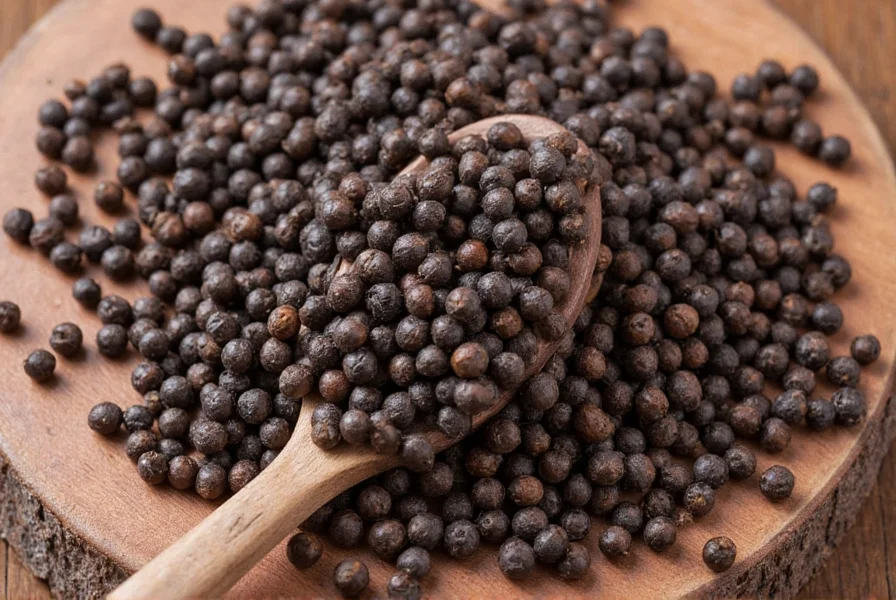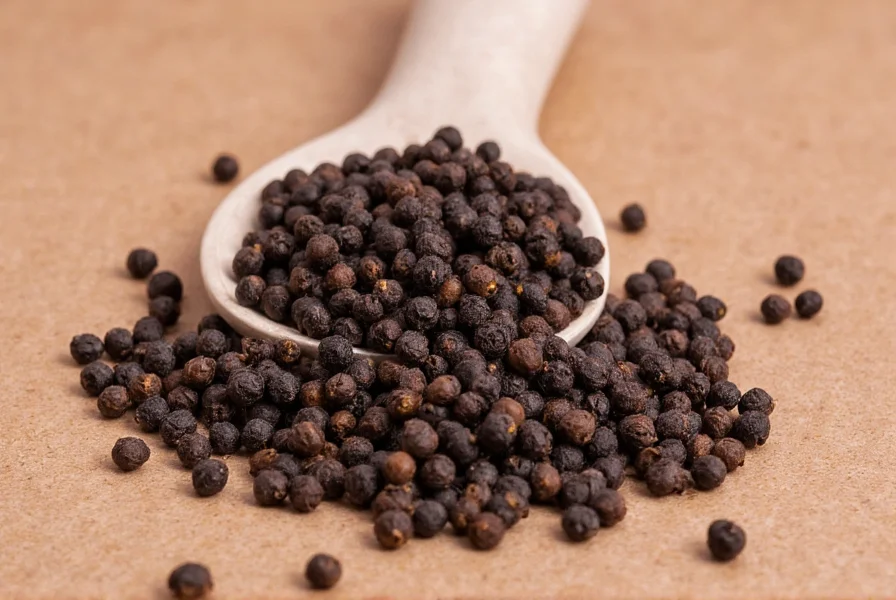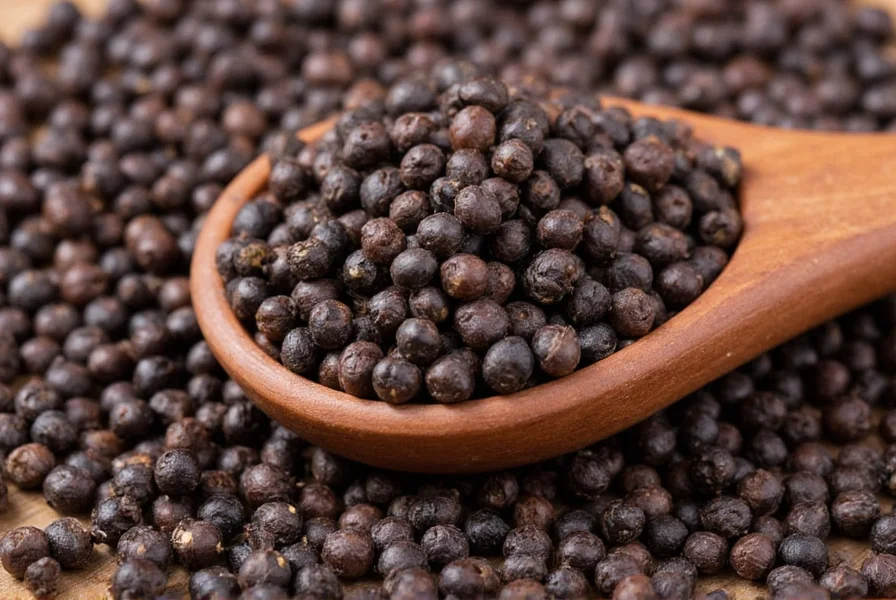Understanding what black pepper is begins with its botanical identity. This versatile spice comes from Piper nigrum, a perennial climbing vine in the Piperaceae family. Unlike chili peppers that belong to the Capsicum genus, black pepper's heat comes from piperine rather than capsaicin, creating a different sensory experience that has made it the world's most traded spice for millennia.
Botanical Characteristics of Black Pepper
The black pepper plant grows as a vine reaching up to 15 meters high, using host trees or structures for support. Its leaves are alternate, entire, and about 5-10 cm long. The flowers are small and clustered on pendulous spikes that eventually develop into the peppercorns. These berries start green, turn red when ripe, and become black through the drying process.
| Pepper Type | Processing Method | Flavor Profile |
|---|---|---|
| Black Pepper | Unripe berries cooked and sun-dried | Sharp, pungent, complex heat |
| White Pepper | Ripe berries soaked to remove outer layer | Milder, earthier, less complex |
| Green Pepper | Unripe berries preserved | Fresh, herbal, milder heat |
| Red Pepper | Ripe berries dried | Sweet, fruity, moderate heat |
Historical Significance and Global Journey
The question black pepper is what historically reveals one of the most influential spices in human civilization. Native to Kerala in southwestern India, black pepper was so valuable it was called "black gold" and used as currency. Ancient Romans paid for it with gold, and during the Middle Ages, its value sparked global exploration. The search for direct trade routes to India's black pepper origin motivated European explorers like Vasco da Gama.
Unlike chili peppers introduced to Europe by Columbus, black pepper had been traded along established routes for centuries. Its enduring popularity stems from both its distinctive flavor and historical preservative qualities before refrigeration.
The Science Behind Black Pepper's Heat
When exploring what is black pepper made of, the key compound is piperine (C17H19NO3), which constitutes 4-9% of dried peppercorns. This alkaloid stimulates thermoreceptors differently than capsaicin in chili peppers, creating a warming sensation rather than burning heat. Piperine also enhances nutrient absorption, particularly of curcumin in turmeric, making it valuable beyond flavor.
The drying process crucial to how black pepper is produced triggers enzymatic reactions that develop its characteristic pungency and complex flavor notes including floral, woody, and citrus elements. Freshly ground pepper releases volatile oils that quickly dissipate, explaining why pre-ground pepper lacks the depth of freshly milled peppercorns.

Culinary Applications Across Cultures
Understanding black pepper scientific name and properties reveals why it's indispensable in global cuisines. In French cuisine, it features in béarnaise sauce and steak au poivre. Indian cooking uses it in garam masala and many regional spice blends. Scandinavian dishes incorporate it in gravlax preparation. Unlike chili peppers that dominate certain regional cuisines, black pepper appears in virtually every culinary tradition worldwide.
The difference between black pepper and white pepper matters significantly in culinary applications. Chefs choose black pepper for visible specks and robust flavor in steaks and roasts, while white pepper's milder profile works better in light-colored sauces and Chinese cuisine where black specks would be undesirable.
Modern Production and Quality Considerations
Today, Vietnam produces approximately 34% of the world's black pepper, followed by Indonesia, India, and Brazil. The highest quality comes from India's Malabar region and Tellicherry grade peppercorns, which are larger berries harvested at optimal ripeness. When evaluating where does black pepper come from today, consider that terroir significantly affects flavor profiles—pepper from different regions offers distinct tasting notes.
Proper storage maintains quality: keep peppercorns in airtight containers away from light and moisture. Whole peppercorns retain flavor for 2-3 years, while ground pepper loses potency within months. This explains why serious cooks always prefer grinding peppercorns fresh rather than using pre-ground product.

Health Considerations and Research
Research into black pepper health benefits shows promising but preliminary results. Piperine demonstrates antioxidant properties and may enhance bioavailability of certain nutrients. Some studies suggest potential anti-inflammatory effects, though more research is needed. Unlike chili peppers that have been extensively studied for capsaicin's effects, black pepper research focuses primarily on piperine's interaction with other compounds.
It's important to distinguish between culinary use and medicinal claims. While black pepper is generally recognized as safe (GRAS) by food safety authorities, therapeutic applications require professional medical guidance. The question what gives black pepper its heat has scientific answers, but health benefit claims should remain evidence-based and moderate.
Interesting Historical and Cultural Facts
Black pepper's historical significance extends beyond cuisine. In ancient Rome, it was so valuable that Alaric the Visigoth demanded 3,000 pounds of peppercorns as part of Rome's ransom in 408 CE. During the Middle Ages, peppercorns were used as collateral in loans and even accepted as rent payment. The phrase "worth his weight in pepper" reflected its extraordinary value.
The confusion between black pepper and chili peppers stems from Christopher Columbus mistaking American chili peppers for black pepper during his voyages. This historical mix-up explains why we call Capsicum fruits "peppers" despite their botanical unrelatedness to Piper nigrum.
Frequently Asked Questions
What is the scientific name for black pepper?
The scientific name for black pepper is Piper nigrum. This distinguishes it from chili peppers, which belong to the Capsicum genus. Piper nigrum is a flowering vine in the Piperaceae family, native to the Malabar Coast of South India.
How is black pepper different from white pepper?
Black pepper comes from unripe green berries that are cooked and sun-dried, creating the characteristic dark color and complex flavor. White pepper comes from the same plant but uses ripe berries with the outer layer removed through soaking. This results in a milder, earthier flavor profile without the floral notes found in black pepper.
What gives black pepper its heat?
Piperine is the compound responsible for black pepper's heat. Unlike chili peppers that use capsaicin, piperine creates a different sensation - more of a warming heat than burning. Piperine constitutes 4-9% of dried peppercorns and also enhances nutrient absorption, particularly of curcumin in turmeric.
Where does black pepper originally come from?
Black pepper originates from the Malabar Coast in southwestern India, specifically the Kerala region. This area remains renowned for producing high-quality Tellicherry peppercorns. While Vietnam is now the largest producer, the plant's native habitat is the tropical forests of India's Western Ghats mountain range.
Why is freshly ground pepper better than pre-ground?
Freshly ground pepper retains volatile oils and piperine that quickly dissipate after grinding. Pre-ground pepper loses up to 50% of its flavor compounds within weeks. The enzymatic reactions that develop black pepper's complex flavor profile continue until grinding stops them, making freshly milled pepper significantly more aromatic and flavorful.











 浙公网安备
33010002000092号
浙公网安备
33010002000092号 浙B2-20120091-4
浙B2-20120091-4